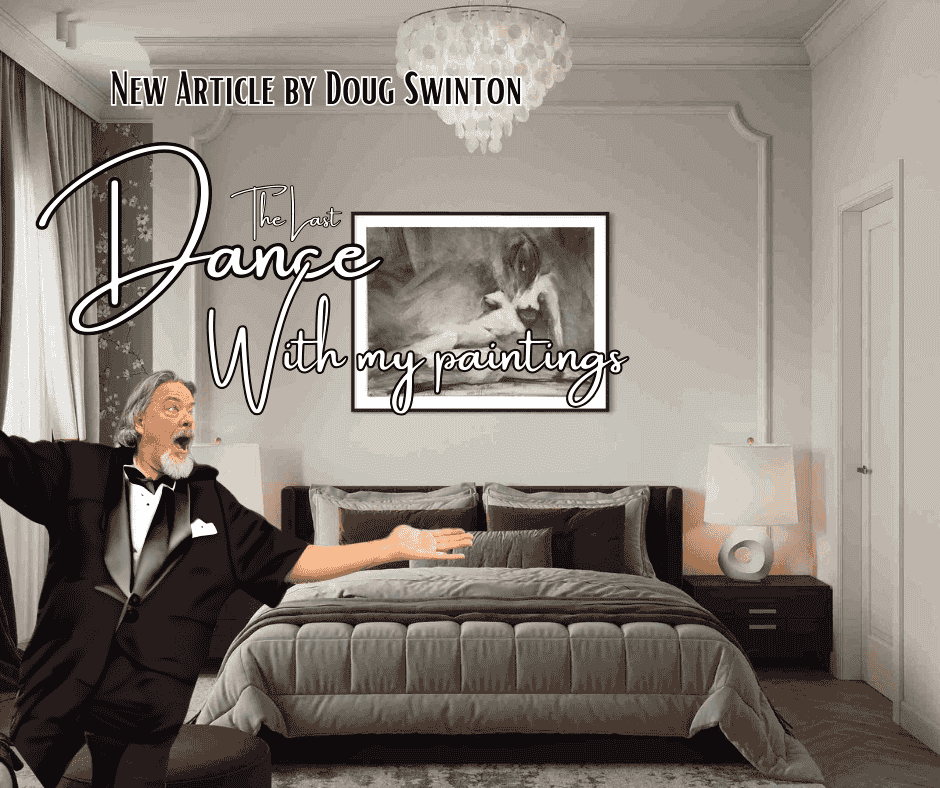How to tell when a painting is finished.
- Doug Swinton

- Jan 5, 2015
- 4 min read
Updated: Nov 18, 2020
Paintings don’t really end, they just arrive at interesting places to stop.

Something happened the other day while I was painting. It has happened before. It’s happened many times before, but this time I decided I would write down all the things that led up to the event and how I can prevent it from happening again. I was working on a painting that was coming along to what I thought was a fairly nice piece of work. I was almost finished when all of a sudden it blew up before my eyes. I had ruined it.
In a matter of a few stokes I had annihilated it. What had started out as a blank canvas was now once again a blank canvas, only this time it had a velvety grey purplish hue. All that was left was a readied tone for the next challenge. Now I have wiped off many a painting before. It no longer bothers me to clean off the canvas for a fresh start. I learned early on from watching Jean Geddes paint, that if it ain’t working it has to go.
We were out in the Kananaskis painting, and she was painting Commonwealth Peak (a challenge even on a clear day). She was trying to capture the clouds that had breezily wrapped themselves around the rocks that were thrusting upwards. She had spent about an hour on the set-up, and just when it was all starting to come together out came a delicate little tissue and war was declared on the painting. Less than one minute later the battle was over. The tissue had won. The painting was no more. I learned a valuable lesson that day. In the book, The Art of War, Sun Tzu says, “To fight and conquer in all your battles is not supreme excellence; supreme excellence consists in breaking the enemy’s resistance without fighting.” If you’re fighting your painting, especially at the beginning, you probably won’t win. Retreat. If you’re fighting your painting in the middle stage, by pulling out more weapons, you certainly won’t win. Brushes and more colour may not be the weapons of choice. You need to break the resistance by finding the motive to your painting, keeping it simple, and staying true to it.
Here are a few tips to keeping your painting on the straight and narrow throughout.
The start;
Paint all the biggest shapes first. You can’t paint the worm hole till you’ve painted the apple. For outdoor-painting I’ve always found it’s better to have a small diamond than a large piece of glass. Try for the “big picture” in the first few strokes. I find that very often it’s the grand gesture made early on that holds the thing together. Don’t be afraid to keep it simple and broad. Take out as much of the noise (detail) as you can. Clive Bell said, “Detail is the degeneration of art, reduce.” There will be time for the noise later. Use a brush that is one size bigger than you think you need. Big brushes won’t let detail creep in. A few minutes of serious contemplation before the first strokes are applied will let you hit early pay dirt too.
The middle;
Overworking takes place when you lose control. As you fail in efficiency and freshness, you try to save all by adding detail. Out comes the little brush and the dab, dab, dab begins. The passage looks laboured. Back to the basics; line, value, shape, colour and edges. Back to the bigger brush. Overworking happens when you’re overtired, distracted, suffering from desire paucity, and particularly when you’re not paying enough attention to reference material or you need to get back to your intended motive. More crudely, it happens when you don’t know what you’re doing. You need to stop and rest, and take a break. No brush strokes go on until you know what it is you want to say. The tip-off comes when you see you’ve gone too far and start to make many mistakes one after the other. Work doesn’t look as good as you know you want it to. “A painting”, says Harley Brown, “is always finished before the artist thinks it is.” Overworking is easily spotted and often ruins the look of an otherwise good painting. If you have gone way too far, it’s tissue time. The overwork boundary often lies in that zone between the intuitive start and the controlled rendering of the middle section. As Ted Smuskiewicz says, “You learn to leave your strokes alone.” No detail yet.
The finish;
My problem wasn’t at the beginning of the painting nor was it in the middle. It was near the end. So how do you know when the painting is finished? Ross Ketcheson always told me, “It takes two people to paint a painting. One to paint the painting and one to hit him over the head when its done.” My problem was that I was tired and made some bad choices. I should have quit. One bad decision led to another. They compounded. The freshness was gone. My palette was dirty and my paint blobs were muddied. My brushes were not being cleaned as they were at the start. I should have taken a break (or three). Really, I should have quit and come back the next day. But noooooo, I forged ahead only to overwork the end and worse, I went back into areas that I had said were great. I was drained. All too often this happens near the end.
Paintings don’t really end, they just arrive at interesting places to stop.
How to know when to stop painting:
You’re tired.
You’re making repeated mistakes.
You’ve lost focus.
You’ve run out of time, light,or the model is gone.
The beer is calling.
Your ride is leaving.
How to know when your painting is finished:
You have nothing more to say.
Robert Genn says “80% finished
is better than 2% overworked.”
Quit while you’re ahead.









Welcome to the ultimate destination where high-class Delhi escorts are ready to make your every moment unforgettable. Dear gentlemen, your search for true pleasure and companionship ends here. We proudly present the finest escorts in Delhi, each one elegant, passionate, and skilled in the art of satisfaction. If you’re craving a touch of sensuality and excitement, this is the place you’ve been dreaming of. Our Escort Delhi agency offers the perfect blend of luxury, beauty, and desire for men who wish to spend time with high-profile call girls who know exactly how to please and comfort you in every way possible.
AV在线看 AV在线看;
自拍流出 自拍流出;
国产视频 国产视频;
日本无码 日本无码;
动漫肉番 动漫肉番;
吃瓜专区 吃瓜专区;
SM调教 SM调教;
ASMR ASMR;
国产探花 国产探花;
强奸乱伦 强奸乱伦;
AV在线看 AV在线看;
自拍流出 自拍流出;
国产视频 国产视频;
日本无码 日本无码;
动漫肉番 动漫肉番;
吃瓜专区 吃瓜专区;
SM调教 SM调教;
ASMR ASMR;
国产探花 国产探花;
强奸乱伦 强奸乱伦;
代发外链 提权重点击找我;
谷歌蜘蛛池 谷歌蜘蛛池;
Fortune Tiger…
Fortune Tiger…
谷歌权重提升/ 谷歌权重提升;
谷歌seo 谷歌seo;
谷歌霸屏 谷歌霸屏
蜘蛛池 蜘蛛池
谷歌快排 谷歌快排
Google外链 Google外链
谷歌留痕 谷歌留痕
Gái Gọi…
Gái Gọi…
Dịch Vụ…
谷歌霸屏 谷歌霸屏
负面删除 负面删除
币圈推广 币圈推广
Google权重提升 Google权重提升
Google外链 Google外链
google留痕 google留痕
代发外链 提权重点击找我;
谷歌蜘蛛池 谷歌蜘蛛池;
Fortune Tiger…
Fortune Tiger…
谷歌权重提升/ 谷歌权重提升;
谷歌seo 谷歌seo;
谷歌霸屏 谷歌霸屏
蜘蛛池 蜘蛛池
谷歌快排 谷歌快排
Google外链 Google外链
谷歌留痕 谷歌留痕
Gái Gọi…
Gái Gọi…
Dịch Vụ…
谷歌霸屏 谷歌霸屏
负面删除 负面删除
币圈推广 币圈推广
Google权重提升 Google权重提升
Google外链 Google外链
google留痕 google留痕